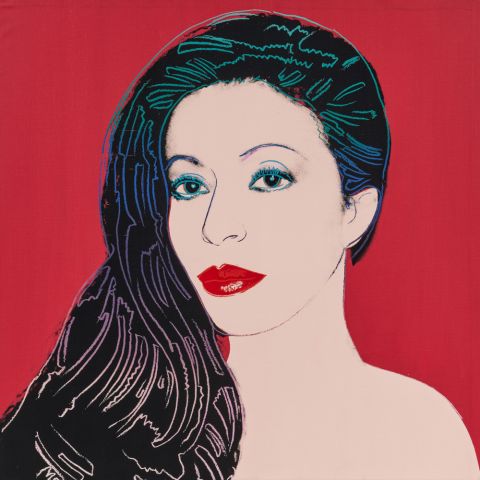
Lot 49 | A.R. Penck | "The Future of the Soldier"
1939 Dresden - 2017 Zurich
Title: "The Future of the Soldier".
Date: 1985.
Technique: Oil on canvas.
Measurement: 80 x 140cm.
Notation: Titled and signed verso on the stretcher at the top: the future of the soldier ar. penck.
Frame/Pedestal: Studio bar.
Provenance:
- Galerie Michael Werner, Cologne (adhesive label)
- Mary Boone, New York (adhesive label)
- Private collection (acquired from previous owner)
- Christie's London, Auction 15474, 7th March 2018, lot 131 (adhesive label)
- Private collection, Netherlands
- Captivates with the symbolic imagery so characteristic of Penck
- The 1980s represent one of the artist's most important periods
- A work of high contrast that illustrates Penck's visual thinking
- With his abstracted forms, Penck depicts the relationship between humankind and its environment
Significant pseudonym
A.R. Penck is regarded as the father of the ‘Neue Wilde’ and is one of the main representatives of new German painting in the 1980s. Born Ralf Winkler in Dresden in 1939, the three-time documenta participant (1972, 1982 and 1992) was embedded in the repressive political system of the GDR, which severely restricted his non-conformist artistic endeavours. He chose the pseudonym ‘A.R. Penck’ in deliberate reference to the geologist and ice age researcher Albrecht Penck (1858-1945), as he recognised the foundations of his own artistic expression in archaic cave painting and archaeology. Based on the analogy between compressed layers of rock and condensed information, Penck developed a pictorial language of signs and symbols. In abstraction, he found an authentic expression and liberation from the reality-bound representation of the visible - but above all from the constraints of Socialist Realism.
Universally valid pictorial formulas: the StandART system
Penck emancipated himself by creating a personal reference system that incorporated ideas from philosophy, natural science, information theory and technology alongside artistic and social issues. Above all, his interest in physics, especially mechanics, is expressed in notes with graphic representations of vectors, scale divisions and interpenetrating force fields. Penck claimed to pursue science with his art and to depict complicated facts with the greatest possible clarity. However, Penck's pictorial research focuses less on machines and more on people in their relationships and social structures.
By reducing his work to simple geometric forms and vectors, Penck developed the ciphers and line figures that have become the epitome of his art and that define the ‘standardised’ vocabulary of his ‘StandART’ system. "A picture is only a standard if its structure is so simple that anyone can perceive and imitate it... Traffic signs, trade marks, signs belong to the standard. I repeat: it is not the primitiveness that characterises a standard, but the operational access with regard to the actual perception and imitation of a standard image." (A.R. Penck quoted from A.R. Penck: Was ist Standart, Cologne, New York 1970, n.p.)
Militant soldier figure
A.R. Penck, who was banned from exhibiting in 1962, maintained close ties to the West German art scene until his expatriation in 1980. His friend and gallery owner Michael Werner played a decisive role in the successful and far-reaching international dissemination of his work. The Future of the Soldier (1985) was exhibited for the first time in his Cologne gallery. The painting captivates with the characteristic symbolism of the assembled pictorial elements and a strongly contrasting colour scheme. Spontaneous lines are sketched into the fluid painting material of the grey background, giving it the appearance of a palimpsest of past traces. Round, triangular, quadrangular and pentagonal (archetypal) shapes in brown and black are arranged on the surface. Out of this muted colour spectrum, which denotes earth and stones, a stick figure emerges in blazing fiery red in a combative posture, armed with a long spear and a ball, perhaps as an iconographic reference to depictions of the Last Judgement and Christ as the ruler of the world.
An illustration of criticism of the system?
The shape and colour of the spear, the points of which are pointing in opposite directions, correspond to the inverted exclamation marks on the left-hand edge of the picture. The combination of spear, arrow and exclamation mark, but also of polygons and stones, illustrates Penck's visual thinking: describing the world and its conflicts, for example between East and West Germany, schematically as if on a diagram. His highly stylised protagonist thus appears as the embodiment of resistance and fortitude. A.R. Penck understands the human being as part of a universal relationship structure that includes society and the environment. His subjective ‘world and system images’ and ‘experiential spaces’ are visualisations of (tense) relationships and ‘postural dependencies’: for example, between the individual and the collective, between figure and ground. As phenomenologically motivated overviews, they ultimately attain universal validity.
Bettina Haiss
Print this lot | Recommend lot |
Conditions of this Lot
32% buyer’s premium on the hammer price
Estimated shipping costs for this lot:
Arrangement after the auction.
A.R. Penck Germany Neo-Expressionism Figurative Painting Neue Wilde Post-War Art Post War 1980s Studio bar Figure / Figures Painting Oil Abstract
More lots which could be of your interest
- Estimate: 18.000 - 24.000 €
04.12.2025 - ca.17:15Modern | Post War | Contemporary | Galerie Thomas | The Jagdfeld Collection | Auction 03.12.2025 - Estimate: 15.000 - 20.000 €
04.12.2025 - ca.17:15Modern | Post War | Contemporary | Galerie Thomas | The Jagdfeld Collection | Auction 03.12.2025 - Estimate: 7.000 - 10.000 €
04.12.2025 - ca.17:16Modern | Post War | Contemporary | Galerie Thomas | The Jagdfeld Collection | Auction 03.12.2025 - Estimate: 15.000 - 20.000 €
04.12.2025 - ca.17:17Modern | Post War | Contemporary | Galerie Thomas | The Jagdfeld Collection | Auction 03.12.2025










